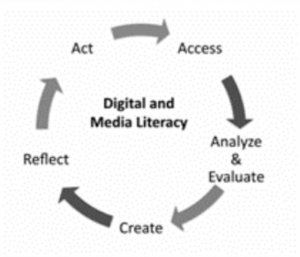Recap of my time with No Cap
Before I actually start with my final blog post, which will be following a more conventional academic structure than my previous ones, I would like to briefly reflect on my experiences and personal learnings from this assignment.
I have found it a quite time-consuming project considering that we, a motley group of four living in three different time zones, had to design a global multimedia site from scratch before producing the content of four blog posts each whilst maintaining the website and share content on social media to increase web site traffic and to build our brand.
Still, I’ve seen it as a very interesting, enjoyable, and particularly instructive project!
Being a veterinarian by profession I initially was not sure what New Media (NM) and Information and Communications Technology (ICT) really imply nor its effect on development and when asking people in my environment who do not work in development I realized that none of them have an understanding of what NMICT&D means. Thus I decided impulsively to write the four blog posts about my personal learning pathway in all this and how an Austrian veterinarian ended up living in Mexico, studying Communication of Development at Malmö University in Sweden.
I read and googled a lot about this tremendous realm of NM and ICT and the deeper I dug into this sphere the more I learned both how difficult it is to find one’s way in this wealth of information and misinformation and how important digital literacy has become, especially in these days of at-home learning and working due to COVID-19.
However, writing blogs in my personal language and style was not only very enjoyable, but I also got inspiring feedback from people who read my articles although they are not naturally interested in information and communications technology or in development work. Through my blog posts, I want to connect with the reader, share my enlightenment and notion to open up new directions on my readers’ mind, I want to express alternative ideas and inspire fresh thinking towards a positive change (Denskus & Papan, 2013).
**********************************
Digital literacy.
The Internet is no longer a luxury.
Introduction
We share a world where everything is faster, better, and more globalized. Everything is everywhere available – information as well as commodities. I assume this is your perception when living in a so-called developed country. But let me poke you, my virtual friend, and enlighten you that almost fifty percent of the world’s population still is excluded from digital technologies (World Economic Forum, 2020), that almost 839 million students do not have access to a computer and more than forty percent do not have internet access at home (UNESCO, 2020), which has become severer than ever due to the global crisis in 2020.
In this last blog post, I want to further investigate the subject of digital literacy, having access to a technical device plus the ability to understand and use technology, but also convey a deeper understanding of the digital divide, the growing gap between people having access to information and communication technologies and those who have not, and how this not only widens the already existing digital education gap but leads to social divide and its negative effect on social mobility of individuals and groups.
**********************************
Digital literacy – what does that mean?
We live in the digital age where ICTs have become more and more available and increasingly pervasive in our lives and we have to learn to adapt to this rapidly changing and modern style of life. Due to technology, the pace of change in our world is accelerating, and bizarrely it is technology who is helping us to manage this change. Digital competence is more essential than ever to keep on learning, working, and communicating in a society of partial or full lockdowns and social distancing due to SARS-CoV-2 Coronavirus.
So, does digital literacy mean to have access to a computer (or another technical device) plus access to (reliable) internet?
Digital literacy = access to a computer + access to the internet. That is only half the story.
Digital literacy is more than only having access to a computer. Becoming digitally competent is beyond being able to read content on a technical device. Being digital literate is also about understanding the written data, processing the information, constructing new knowledge to finally improve the personal circumstances (Martin & Grudziecki, 2015, p. 254). It also involves the ability of critical thinking to make informed decisions that lead to positive change (Heeks, 2017, p. 58). Digital literacy aims to protect internet users from fraud and negative influences. And last but not least: Digital literate persons have the opportunity to communicate with others and stay connected in a time where our lives have become more digital than ever.
Taken all together digital literacy is having the knowledge of how to access digital data, how to assess it, and how to apply it (Hobbs 2010, p. 18).
Figure 1: Essential competencies of Digital Literacy (Hobbs, 2010)
**********************************
How can you establish digital proficiency?
Children, adolescents, and adults spend a lot of hours consuming entertainment media like watching Netflix, playing video games, or interacting on social networks although their computer or mobile phone would make it easily feasible to explore unknown areas and learn new things. But, as Hargittai and Waleiko (2008) state, they simply lack the knowledge of how to do it (as cited in Hobbs, 2010, p. 26).
So, how can you learn these necessary skills and become a digital citizen? Ironically enough: Online. Next to numerous online courses, the internet is full of data that provides helpful hints and life hacks. Another odd source of sharing information seems to be social media although opinions are divided. Many teachers see social media as the “bad internet”, being the destroyer of the educational system whilst various students feel that social media has helped them improving their reading and writing competencies to avoid the humiliation of misspelled words in front of their fellow students. Also, they deem to gain autonomy from adults in order to develop their own experiences in their interpersonal relationships and communication. On the other hand, lower class parents as opposed to better educated and wealthier parents, hope that social media give their children the required ICT skills in order to achieve success in their future lives to improve their social position (Miller, 2016, p. 73).
However, in times of online teaching, I reckon that school is a significant place to learn how to use technology proficiently and how to become a smart consumer in the World Wide Web.
**********************************
The digital divide – imbalance exists
We’ve learned so far that ICTs have drastically changed the way of how we work, study, communicate, and enjoy our leisure time. Even if the Internet will not automatically improve education, so at least it gives us the opportunity to access valuable data. It furthermore provides jobs and helps to achieve our goals. Access to the online world creates relationships among people with similar interests and entertains us. Some see the internet as a pathway out of poverty, some benefit from it to stay connected with their beloved ones.
So far so great. But.

Figure 2: The internet world map shows the number of internet users (IBERDROLA, 2020 Mai)
4.57 billion people were active internet users which are 58 percent of the world population (Statista, 2020).

Figure 3: Global digital population as of July 2020 (in billions) (Statista, 2020 October)
Although there are more and more people around the world getting access to the World Wide Web, there is still a vast number of those who have not. The digital divide refers to the gap between the privileged members of society, regardless of whether being individuals, groups or entire countries that benefit from having sufficient knowledge and access to technology and those who are left behind (Heeks, 2017, p. 85).
It is usually the population living in rural settlements, or less developed countries, elderly people, or less educated ones that suffer from this digital inequity. This uneven distribution of ICTs hence results in that richer countries and richer individuals can increase their advantages and opportunities whilst the poorer ones miss out on possible resources that they could access online (Heeks, 2017, p. 16).
**********************************
COVID-19. And the digital education gap is widening
With the global spread of the coronavirus for students, the willingness to learn is not enough anymore. I live in Mexico, a country where already before COVID-19 education was in a crisis. Due to the pandemic, schools there have been closed for over eight months now and educational success presently depends on access to technology. However, students from underprivileged families or disadvantaged communities lack this access to ICTs.
“We need to ensure that we do not leave those who are less digitally equipped even further behind in a post-coronavirus world.” (Shamika Sirimanne, UNCTAD Technology and Logistics Director.)
According to CNN (2020), only 56% of the homes in Mexico (according to government statistics) have access to the internet thus 13 million students have not got the opportunity to study remotely in the virtual classroom. Worldwide there are almost 830 million learners who do not have access to a computer and additionally, more than forty percent do not have Internet access at home (UNESCO, 2020).
The justified question may then arise as to how children have been able to continue learning during school closures when lacking access to the Internet, a computer, or both? How can they be reached if not online? As you can read in my blog post No Cap – Education Gap unprivileged students in Mexico who do not have internet connection or technical devices have the “opportunity” to study remotely via television or radio. Surely, this is better than nothing. But this, just as surely, also widens the already existing knowledge gap even more and gives space to a greater inequality within a society. Rich children receive better education whilst the poor experience (once more) their disadvantage. Low education leads to lowered economic prospects later in life and this is not really helpful to eradicate poverty, to end hunger, or to ensure healthy lives. Let alone the children’s talents that are swept under the carpet.
**********************************
ICTs and social value
In addition to educational value, access to information and communications technology also brings self-esteem and social value (Miller, 2016, p. 133). Heeks (2017) describes in his book Information and Communication Technology for Development a conversation with a woman in rural Karnataka, India about the significance of ICTs. She illustrates that when traveling to the state capital “she wanted to look like she belonged there”, and having a mobile phone helped her in doing so (p. 192). Social media, for example, helps people to portray themselves in the light they want to be seen, although I find it is doubtful whether that is good or bad. However, having access to ICTs evokes the feeling of moving out of poverty towards modernity, urbanity, and wealth. And who knows? Having great pictures might help when applying for a new job.
**********************************
Conclusion
The Internet is no longer just a luxury. Being part of the online world has become even more eminent than ever in times where numerous people are isolated and cut off, where myriad students are forced to learn remotely due to the ongoing pandemic. Since it is quite challenging to find accurate results in this wealth of information and misinformation in the World Wide Web it is not enough to have access to a computer and the internet, but inevitable to have the knowledge of how to access, assess and apply digital data (Hobbs, 2010, p. 18) in order to be a smart consumer. An important prerequisite for becoming a digital citizen is to live in an environment where access to technical devices and the internet is guaranteed. Unfortunately, over forty percent of the world population lack this access (Statista, 2020), hence there is a growing digital gap in society between those who have access to ICTs and those who have not. Digital inequality is evident and cannot be denied.
What are your thoughts on this? Is it possible to narrow or even close the digital gap?

Reference
Denskus, T. & Papan, A. (2013, June 18). Reflexive engagements: the international development blogging evolution and its challenges, Development in Practice 23:4, 435-447. Retrieved from file:///C:/Users/HP-NB/Downloads/DenskusPapan_Development%20Blogging%20Evolution_DiP%20(1).pdf
Heeks, R. (2017). Information and communication technology for development (ict4d). ProQuest Ebook Central https://ebookcentral.proquest.com
Hobbs, R. (2010). Digital and media literacy: A plan of action. Washington, D.C.: The Aspen Institute
Martin, A. & Grudziecki, J. (2015, December 15). DigEuLit: Concepts and tools for digital literacy development, innovation in teaching and learning in information and computer sciences, 5:4, 249-267. Retrieved from https://www.tandfonline.com/doi/full/10.11120/ital.2006.05040249
Miller, D., at al. (2016). How the world changed social media. London: UCL Press
Rivers, M. & Suarez, K. & Gallón, N. (2020, August 27). Mexico’s solution to the Covid-19 educational crisis: Put school on television. CNN. Retrieved from https://edition.cnn.com/2020/08/22/americas/mexico-covid-19-classes-on-tv-intl/index.html
UNCTAD. (2020, April 06). Coronavirus reveals need to bridge the digital divide. Retrieved from https://unctad.org/news/coronavirus-reveals-need-bridge-digital-divide
UNESCO. (2020, April 21). Startling digital divides in distance learning emerge. Retrieved from https://en.unesco.org/news/startling-digital-divides-distance-learning-emerge
World Economic Forum & World Bank Group & ITU & GSMA. (2020, April). Digital development joint action plan and call for action. COVID-19 crisis response. Retrieved from http://www3.weforum.org/docs/WEF_Digital_Development_Joint_Action_Plan_Call_for_Action_report_2020.pdf
Figure 1: Hobbs R. (2010). Digital and media literacy: A plan of action. Retrieved from https://assets.aspeninstitute.org/content/uploads/2010/11/Digital_and_Media_Literacy.pdf
Figure 2: IBERDROLA (2020, May). Digital divide throughout the world and why it causes inequality. Retrieved from https://www.iberdrola.com/social-commitment/what-is-digital-divide
Figure 3: Statista (2020, October 29). Worldwide digital population as of July 2020. Retrieved from https://www.statista.com/statistics/617136/digital-population-worldwide/#:~:text=How%20many%20people%20use%20the,percent%20of%20the%20global%20population.

